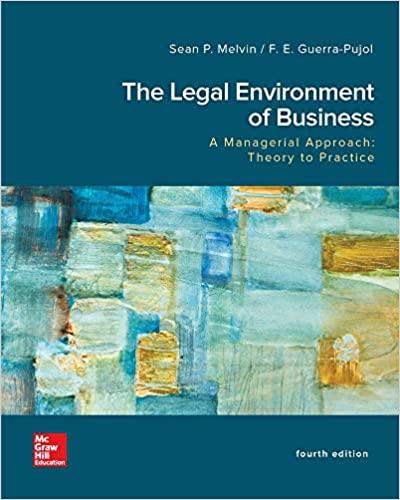Question
Problem 6-28: While treating Martha Kawaahau for an infection, Dr. Paul Geiger knowingly and deliberately prescribed a course of antibiotic treatment that he knew was
Problem 6-28: While treating Martha Kawaahau for an infection, Dr. Paul Geiger knowingly and deliberately prescribed a course of antibiotic treatment that he knew was not as effective as other alternatives, and, then, without explanation, he ceased all treatment, eventually causing Ms. Kawaahau to have her leg amputated. When Dr. Geiger filed for bankruptcy, Ms. Kawaahau asserted that her claim arose out of a willful and malicious injury committed by Dr. Geiger and, as such, was nondischargeable under section 523(a)(6). What result? See Kawaauhau v. Geiger, 523 U.S. 57 (1998).PLEASE REFERNCE THE CASE
Problem 6-29: Ponoroff creates a trust for his children and funds it with the huge royalties he receives from sales of his seriously overpriced bankruptcy casebook. As a favor to Ponoroff, Epstein agrees to act as trustee, something he has never done before. A couple of years later. Epstein finds himself strapped for cash and obtains Ponoroff's permission to arrange for the trust to make him a short-term loan at a market rate of interest. The loan is eventually repaid, but upon learning what happened, Ponoroffs children, the trust beneficiaries, sue Epstein in state court for having breached his fiduciary duty by engaging in self-dealing with the trust. The court enters judgment in favor of the children and against Epstein for $10,000. Epstein thereafter files for bankruptcy and seeks to discharge the debt. The children file a complaint under section 523(c)(1) seeking to have the debt declared non-dischargeable under section 523(a) (4). What result?
Problem 6-30: Epstein fraudulently induced Ponoroff to buy his car, telling him that it got 35 miles per gallon. Epstein knew that to be false and knew that the car's mileage was a key selling point for Ponoroff. Ponoroff has known Epstein for a while, and has no reason to doubt him-until that is he finds that the car he bought only gets 15 mpg. He sues Epstein and obtains a state court judgment for fraud in the amount of $15,000. Epstein then files bankruptcy under Chapter 7. The clerk sets the date for the first meeting of creditors as May 1. On July 10, Ponoroff then files a motion for summary judgment, citing the state court judgment, the admissibility of which Epstein does not contest. However, Epstein files a counter motion for summary judgment. Who wins, and why? Before answering this question (but not before thinking about it), read the next case.
Problem 6-31: Suppose Nickles is fraudulently induced to lend money to Ponoroff. Predictably, Ponoroff defaults on the loan and Nickles obtains judgment against Ponoroff in state court based on breach of the promise to repay. Ponoroff does not appeal. Nickles did not seek or obtain a finding of fraud in that suit, although he might have, because he was simply interested in getting a judgment against Ponoroff as quickly as possible. Before Nickles can collect on the judgment, Ponoroff files bankruptcy. Nickles promptly files a nondischargeability complaint under section 523(c)(1) based on section 523(a) (2). Ponoroff moves to dismiss based on the doctrine of res judicata (claim preclusion), which holds that a party is barred from re-litigating grounds for (or defenses to) a cause of action that were available to that party in an earlier suit, regardless of whether or not raised in that suit. What result on Ponoroff's motion? See Brown u. Felson, 442 U.S. 127, 138 (1979). PLEASE REFERENCE THE CASE
Step by Step Solution
There are 3 Steps involved in it
Step: 1

Get Instant Access to Expert-Tailored Solutions
See step-by-step solutions with expert insights and AI powered tools for academic success
Step: 2

Step: 3

Ace Your Homework with AI
Get the answers you need in no time with our AI-driven, step-by-step assistance
Get Started


